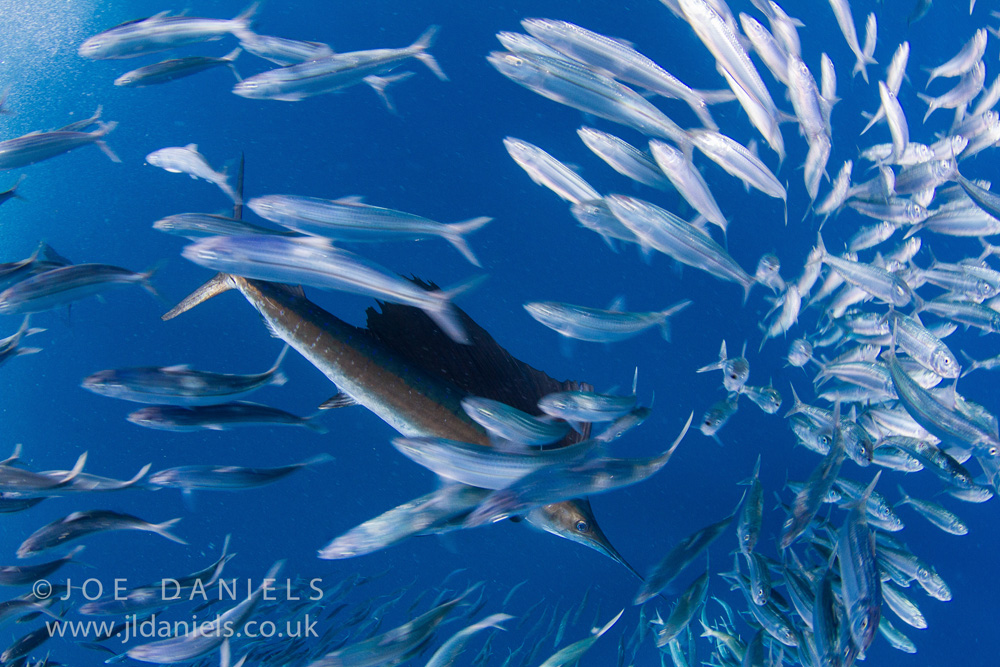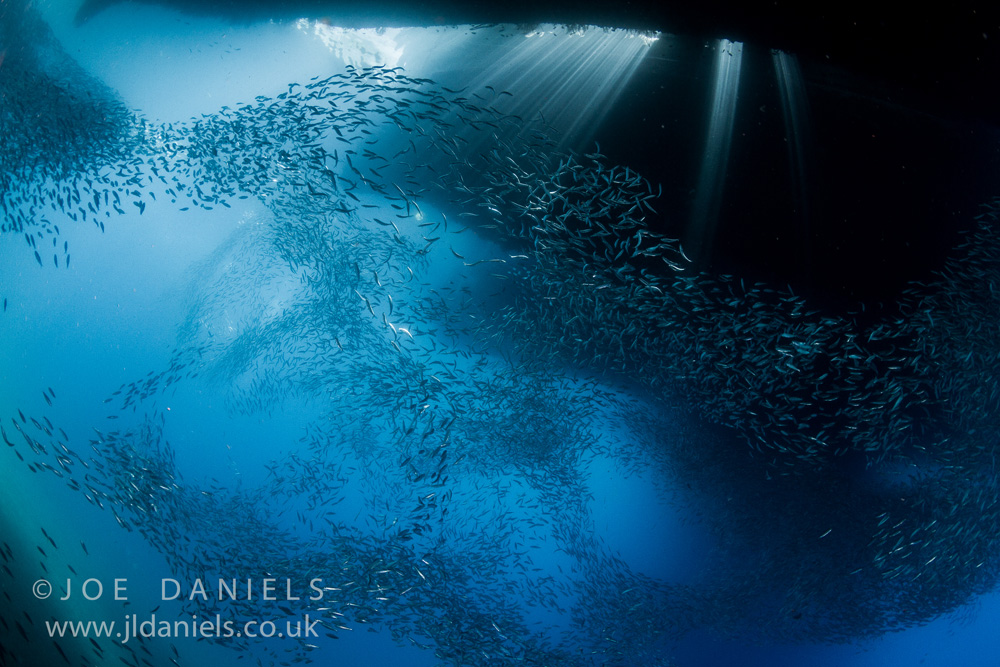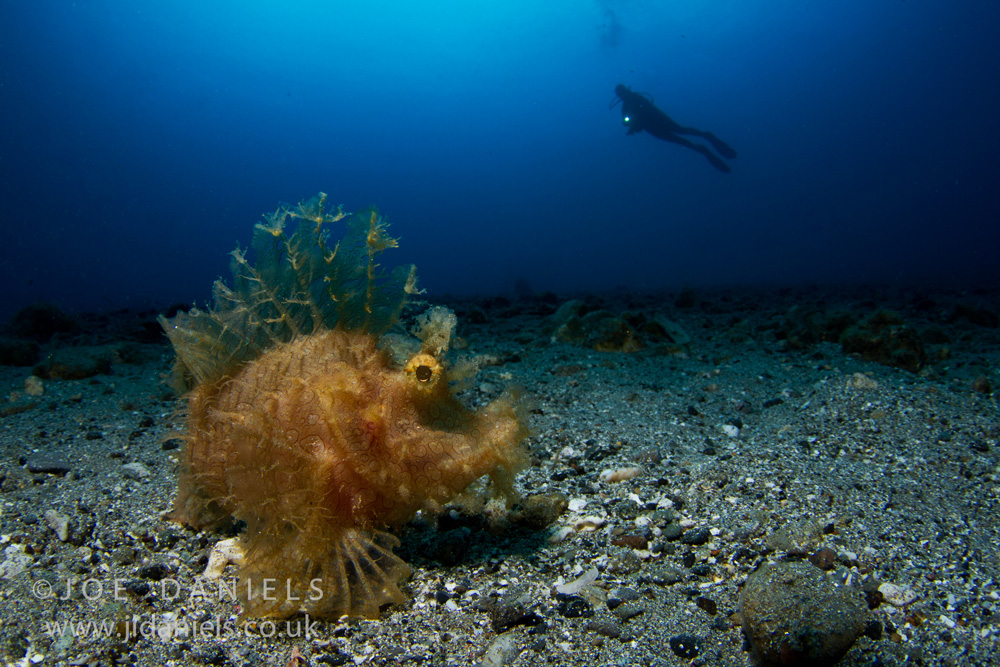News
Scubaverse Underwater Photographer Interview: Joe Daniels

In an ongoing series, Scubaverse.com’s Underwater Photography Editors Nick and Caroline Robertson-Brown talk to underwater photographers from around the world that they admire.
This interview is with award-winning photographer Joe Daniels.
 Thank you for asking me to participate in this interview! Originally I am from Suffolk, England and I am now based in South West France. For the past ten years I have been fortunate enough to work on various different marine conservation projects and diving operations around the world. Through diving and spending a lot of time underwater I developed a passion for underwater photography. Now I can’t bear to be in the water without a camera, whether it’s a murky pond or bustling coral reef.
Thank you for asking me to participate in this interview! Originally I am from Suffolk, England and I am now based in South West France. For the past ten years I have been fortunate enough to work on various different marine conservation projects and diving operations around the world. Through diving and spending a lot of time underwater I developed a passion for underwater photography. Now I can’t bear to be in the water without a camera, whether it’s a murky pond or bustling coral reef.
My highest achieving image so far would probably be my Tunicate Shrimp which earnt gold in the Traditional Macro category in the Our World Underwater competition. I have also placed in Outdoor Photographer of the year twice, HIPA Life in Colour and World Oceans Day photo competition. A Whale Shark image of mine was used in BEIJING by Humane Society International and the Jane Goodall Institute. The exhibit, entitled “The Price Behind the Taste—Protect Sharks, Don’t Eat Shark Fins,” was to enlist public support for the protection of sharks. I was very proud to be included in this campaign.
So far in my career I have spent the majority of my time across two locations – The muck diving mecca of Ambon in eastern Indonesia and the idyllic Indian Ocean archipelago of Seychelles. The two locations could not be more different photographically which I think helps diversify my portfolio. I have also been to Raja Ampat twice in the past three years, the marine life there is astounding and is very hard to beat.
N/C: How did your underwater photography start?
JD: As soon as I left college I went and volunteered on a Marine Conservation Project in Seychelles. There I was involved in reef monitoring where we did 2 survey dives per day from Monday to Friday. This wasn’t enough in water time for me so I spent all my spare time and weekends snorkelling. One weekend I borrowed a small clear dry bag for my pentax point and shoot camera. After going out snorkelling with the camera and taking some terrible pictures of Turtles and various corals I was hooked.

N/C: What is your favourite u/w camera equipment (past & present) & why?
JD: I love to shoot cfwa images so my Nauticam mini dome and Tokina 10-17mm fisheye is a favourite set up of mine. I have also recently acquired a Trioplan 100mm f2.8 so I am looking forward to shooting and experimenting with that later this year.

N/C: What would be your advice to anyone new to underwater photography?
JD: Not to get obsessed buying the latest and greatest camera setup. Of course buy the best you can afford, but it’s not everything. Focus on subject selection, composition and light. It also makes a huge difference if you are a comfortable and competent underwater.

N/C: What, or who, has been your single biggest inspiration for your underwater photography?
JD: When I first started taking pictures underwater I loved to show people what I had seen whilst I was underwater, I still do. Now I like to show people things that they may have never seen before, or animals they know of but shown in a different way. I just want to share my enthusiasm for the underwater world and hopefully get others excited about it too. There are many photographers that inspire my work, notably Thomas Peschak his images continually amaze me. Alex Mustard’s images are a technical masterclass and are always a joy to behold. Eduardo Acevedo Fernandez, Laurent Ballesta and David Doubilet all produce jaw dropping images and all have large influences on my work.
N/C: Where is your favourite dive location, and is it for the photography?
JD: This is a tough question. I have favourite locations for differing reasons, and there are many places I have not had the chance to get to yet. For macro it has to be Ambon. The abundance of subjects there is endless. The thing I like most about diving in Ambon is that it’s not just macro. There are incredible jetty’s, caves, reefs and even a wreck. So photographically its fantastic. For wide angle I would have to say Misool in Raja Ampat. The health and diversity of the reef systems there are world class. It is also a massive conservation success story being protect by a patrolled no take zone which is twice the size of Singapore. The Yucatan Peninsular, Mexico also has some spectacular photographic opportunities with its Cenotes, Sailfish and Sharks. Finally Seychelles will always be a special place for me where I’ve had many special encounters.

N/C: What are you views on marine life manipulation, moving subjects?
JD: With regards to moving subjects especially in macro photography I am against it. Picking animals up and moving them just for a photo is not acceptable. I would be a hypocrite if I was to say that I didn’t have images where the animal had been coaxed a little to get a better image. I think there would be very few photographers that have never coaxed a critter to a different position for a better image, if they are honest. I think with the rise of social media it has got out of hand as macro photography is very competitive now, photographers are so focused on getting as many likes as possible their ethics go out of the window a bit. On the other hand I have been on dives with photographers that are very anti manipulation and will not tolerate it at all, but will then take hundreds of pictures of one subject then swim straight over the subject wiping it out in one fin kick and not even noticing.
Every time we enter the water we make an impact, it’s what we do to reduce this impact. Don’t forget those basic diving skills you learnt in your open water course and be specially aware. Talk to your dive guide and ask them just to show you, instead of positioning. They are just trying to please you when they move things as it usually increases their tip. The dive operations can also have a code of conduct for photographers to abide by whilst diving to reduce their impact. Marine life manipulation is not isolated to macro photography. Tiger Beach is a good example, the sharks are lured in front of photographers cameras with bait for sunset splits or a perfect pass. I’m not saying I’m against shark diving practices, quite the opposite. If we can make them financially profitable sharks are much less likely to be killed for their fins. I suppose what I am trying to say it that it’s not a Black & White issue. We have to be responsible in our actions and have some foresight to ensure these amazing creatures continue to thrive and photographers can continue to photograph them. So the less we poke and prod them the more likely they are to stick around.

N/C: What do you look for when you are making your images?
JD: It depends on what I’m shooting and in what conditions I am shooting in. For macro I am looking for a willing subject in a good position, generally raised up off the substrate if I want a black background. What I really like to shoot is a subject with an attractive background. If there is current or surge I will try and stay away from super macro and shallow DOF. For wide angle I am always looking for the best light, I can’t resist a Indonesian jetty with shafts of light streaming through the wooden slats. When the light is good I’m looking for a subject to fill the foreground and complete the image. I also love to incorporate the surface into my images, whether it’s a split image or incorporating Snell’s window. These are usually the images that stand out to people that are not divers or spend much time underwater. I think it gives the viewer something to relate to. No matter what technique I’m using I always shoot to the conditions. Whether that means streamlining my gear to catch up with speeding Sailfish or simplifying my images when there is current. When the conditions change so does my plan for making images, this is not necessarily a bad thing. Varying conditions may diversify your portfolio. One of my favourite images is a Turtle silhouette, instead of the classic sunbeams behind it (which I was initially after) it poured with rain so it has rain drops hitting the surface filling the rest of the frame. Shooting in those conditions created an image that stands out from the rest.

N/C: What motivates you to take u/w photos?
JD: Simply because I love it! I love the whole process of making pictures from deciding what set up to use, setting everything up and being underwater searching for a subject. I love that I can use my images to promote marine conservation issues and to just show to people how amazing the underwater world is. I’m constantly learning and driven to take better pictures.
N/C: If you could photograph any one thing/place what or where would that be?
JD: Although I have been to Raja Ampat twice I would love to go back and visit the Blue Water Mangroves of Misool. A shallow coral reef with over hanging Mangroves and shafts of light streaming through onto Barrel Sponges and Soft corals sounds incredible, everything I like to shoot all rolled into one dive site.

Follow the work of Joe Daniels at www.jldaniels.co.uk or on his Facebook page and instagram @j_l_daniels
Gear News
Introducing the TR-80, IR-50 and CS-30 Regulators from DYNAMICNORD

Whether you are a beginner or a professional diver – with the three new main regulators from DYNAMICNORD, everyone will find their favourite regulator. They all look super stylish.
Excellent performance with the TR-80
Quality and performance are the be-all and end-all for regulators. It is not for nothing that the TR stands for Tec Reg. The innovative design of the TR-80 guarantees absolute reliability – even in ice-cold waters.

Perfect breathing effort at 0.8 J/l / certified for diving in waters below 10 degrees / structural design made of solid brass for best cold protection / membrane-compensated design with dry seal of the first stage / reduced exhalation effort thanks to optimized exhalation membrane and bubble deflector / adjustable Venturi (dive/predive) and adjustment knob for individual inhalation comfort / innovative design of the front cover prevents free-flow in strong currents or when diving with scooters / design made of sandblasted brass, matt chrome finish / 2 HP and 4 LP outlets / mouthpiece made of high-quality, anti-allergic silicone for maximum comfort.


Amazing underwater adventures with the IR-50
The IR-50 is the top regulator for advanced and experienced divers. Natural breathing is the essence of this regulator.

Ideal breathing effort at 0.8 J/l /certified for diving in waters below 10 degrees / compensated membrane / adjustable venturi (dive/predive) and adjustment knob for individual inhalation comfort/ outlet valve and deflector for minimum exhalation effort and reduction of bubbles on the face / design made of sandblasted brass, matt chrome finish / 2 HP and 4 NP outlets / mouthpiece made of high-quality, anti-allergic silicone for maximum comfort.


The Workhorse – our CS-30
For diving centres and diving beginners – the workhorse stands for strong construction, reliability and robustness. Perfect for your training.

Optimal breathing effort at 0.8 J/l /recommended for diving in waters above 10 degrees / non-compensated piston / adjustable venturi (dive/predive) / outlet valve and deflector for minimum exhalation effort and reduction of bubbles on the face / design made of sandblasted brass, matt chrome finish / 1 HP and 3 NP outlets / mouthpiece made of high-quality, anti-allergic silicone for maximum comfort.


Octopus OP-30
The OP-30 is the ideal addition to all DYNAMICNORD regulators. It is identical in construction to the CS-30.

The TR-80, IR-50, CS-30 (DIN & INT) regulators and the Octopus OP-30 are available from DYNAMICNORD dealers and in the online store.
DYNAMICNORD – Your Outdoor Companion.
Marine Life & Conservation
Paul Watson Released as Denmark Blocks Japan’s Extradition Bid

Renowned anti-whaling activist Paul Watson has been released from custody in Greenland after spending five months in detention. Denmark’s Justice Ministry rejected Japan’s request for his extradition, citing insufficient guarantees that his time already served in custody would be credited against any potential sentence.
The 74-year-old Canadian-American was arrested on July 21 in Nuuk, Greenland’s capital, when his ship docked to refuel. His arrest was based on a 2012 Japanese warrant related to a 2010 encounter in Antarctic waters. Japan alleged Watson obstructed operations and caused damage to a whaling research ship during efforts to disrupt illegal whaling. Watson has consistently denied these claims, maintaining his commitment to marine conservation.
Denmark, which oversees extradition matters for Greenland, concluded that while the legal conditions for extradition were met, the lack of assurances from Japan regarding time-served credit made extradition untenable.
In a video shared by his foundation, Watson expressed gratitude and relief, saying, “After five months, it’s good to be out… and good to know they’re not sending me to Japan.” He added that the most difficult part of his time in custody was being separated from his two young sons.
Watson is a pioneering figure in marine conservation, known for founding the Captain Paul Watson Foundation in 2022 after decades of activism with the Sea Shepherd Conservation Society. His bold efforts to defend marine life have earned him widespread support, including from celebrities and conservationists. His work has also been featured in the acclaimed reality TV series Whale Wars.
Watson’s lawyer, Jonas Christoffersen, praised the decision, stating, “We are happy and relieved that Paul Watson is now free.” He added that Watson is eager to reunite with his family and continue his vital work.
The arrest occurred while Watson’s vessel, the M/Y John Paul DeJoria, was en route to the North Pacific with a team of 26 volunteers to intercept a Japanese whaling ship. His foundation described the arrest as politically motivated and emphasized that Watson’s actions were focused on ending illegal whaling practices.
Japan resumed commercial whaling in 2019 after leaving the International Whaling Commission, asserting that whale meat is a cultural tradition. Conservationists, however, continue to challenge these practices, highlighting their impact on marine ecosystems.
Despite the challenges, Watson remains steadfast in his mission to protect marine life and bring attention to whaling practices. His dedication to ocean conservation has made him a globally respected advocate for the environment.
-

 News2 months ago
News2 months agoIconic SS United States to become the World’s Largest Artificial Reef
-

 News3 months ago
News3 months agoBook Review – 52 Assignments: Underwater Photography
-

 Gear News3 months ago
Gear News3 months agoDYNAMICNORD – New German diving brand enters the British market
-

 News3 months ago
News3 months agoExploring Cenote El Pit: A Diver’s Dream
-

 Gear News3 months ago
Gear News3 months agoTry BARE drysuits (and maybe even win one!) this Friday with Sea & Sea at North West Dive Fest
-

 Marine Life & Conservation3 months ago
Marine Life & Conservation3 months agoBook Review: Coral Triangle Cameos
-

 Blogs2 months ago
Blogs2 months agoDive the Egyptian Red Sea this Autumn with Regaldive
-

 News3 months ago
News3 months ago2024 Ocean Art Underwater Photo Competition Announced















